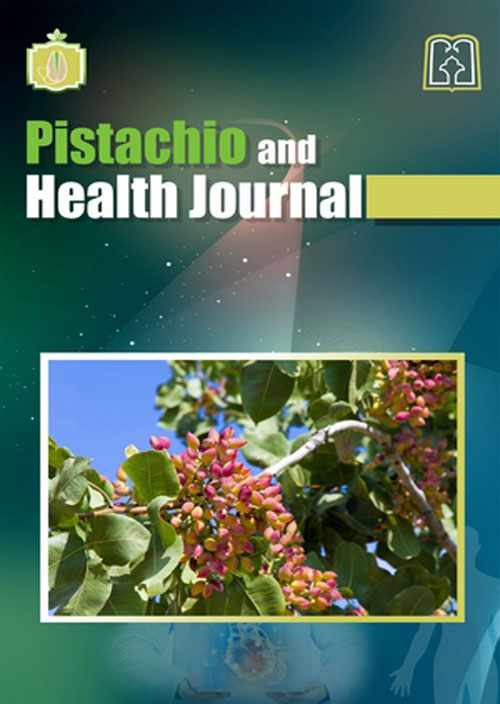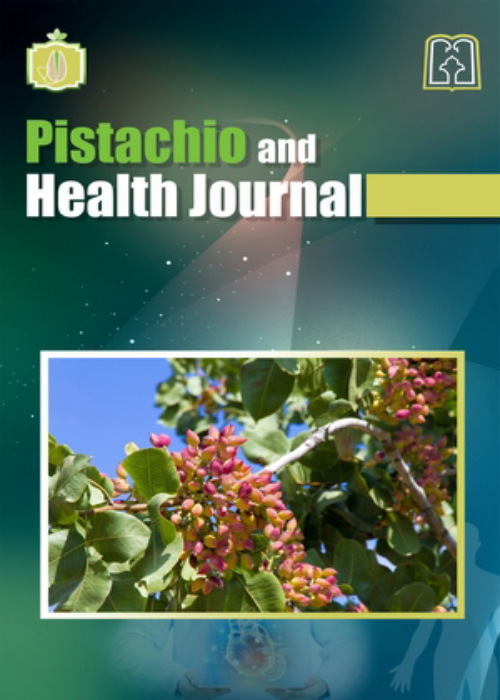فهرست مطالب

Pistachio and Health Journal
Volume:2 Issue: 2, Spring 2019
- تاریخ انتشار: 1398/03/11
- تعداد عناوین: 7
-
-
Pages 1-8Introduction
Drying is one of the most important stages of pistachio processing. The aim of this study was to investigate two common types of dryers available in Rafsanjan with emphasis on health related aspects. Fresh pistachio cultivars of Fandoghi were harvested from Rafsanjan gardens and the pistachio samples were dried after peeling and washing using Silage and Wagon dryers.
Materials and MethodsAfter drying, pistachio cultivars of Fandoghi were tested for 0, 1.5 and 3 months at room temperature (20 ± 2 ºC). Moisture content, peroxide value, conjugated dienes and conjugated triene, mold and yeast count were measured with three replicates. The experiment was conducted as a factorial experiment in a completely randomized design with three replications.
ResultsPeroxide value of dried pistachio samples in two drying machines were in the permissible range (less than 1 millequivalent /kilogram). Silage dryer samples showed less peroxide value, conjugated dienes and conjugated trienes than wagon dryer samples. At the end of the three-month period, the growth rate of mold and yeast in pistachio samples dried using wagon dryer decreased and their growth rate was less than the permissible limit (less than 1000 cell forming unit/gram).
ConclusionMold and yeast growth were not observed in dried pistachio samples using silage dryer. It is recommended to use more silage dryer in pistachio processing units.
Keywords: Pistachio nut, dehydration, Sensory, Health, Storage -
Pages 9-16Introduction
Extracting of genomic DNA with the proper quality and quantity is critical in the molecular identification of insects, whose morphological identification is problematic and affected by specific stage of life, size and sex. Also, storing insects under inappropriate conditions can have damaging effects on the quantity and quality of extracted DNA. Thus, choosing an appropriate protocol to provide pure DNA from these insects is essential.
Materials and MethodsIn the present study to achieve an efficient method for DNA extraction from insect, we have applied and compared three common methods including (CTAB, Chelex and using commercial kit (animal tissue DNA isolation kit)). The quantity and quality of the extracted DNA were measured in two thermal conditions when DNA was stored at both -20 °C and -80 °C. The concentration of DNA extracted was measured on the Thermo Scientific NanoDrop 2000c.
ResultsThe greatest and lowest average nucleic acid concentration of parasitoids were recorded for CTAB and Chelex. The mean DNA yield of parasitoids (Scelionidae) from different collection preservatives indicated that the greatest average DNA yield was recorded for 95% and 99.8% ethanol respectively, and 75% ethanol had the lowest value of average DNA yield.
ConclusionCTAB method as a suitable method. and storing insects in -80°C at 99.8% ethanol as suitable methods with high performance to DNA extraction of parasitoids was suggested.
Keywords: CTAB, Chelex, KIT, Ultra Low Temperature Ethanol Concentration -
Pages 17-25Introduction
The use of pesticides has a significant negative effect on human health. The present study aims to assess pistachio farmers’ knowledge, attitude, and behaviour concerning the environmental effects of using pesticides.
Materials and MethodsThis cross-sectional study was carried out on 140 rural pistachio farmers of Rafsanjan City, Southern Iran, during the period from 2017 to 2018. Data were collected using a questionnaire with the variables of knowledge, attitude, and behaviour, with the validity and reliability of which having been confirmed. After data collection, the data were analysed by SPSS 16.0 using the statistical independent t-test, a one-way ANOVA, and the Pearson’s correlation test. The significance level was set at 0.05.
ResultsThe results showed that there were statistically significant differences (P< 0.05) in the knowledge and attitude level of the research samples upon an increase in the level of literacy between those who participated in the training classes on health and safety principles during the spraying period and those who had not been trained at all. However, there was no statistically significant relationship between the knowledge score of the samples, for health items, and adherence to safety principles during the spraying period in terms of age, work experience, spraying history, and the area under cultivation among the research samples (P> 0.05).
ConclusionIt is suggested that training sessions be held continuously on health issues as well as compliance with safety principles during the spraying period by professionals for all farmers to enhance their level of knowledge and attitude.
Keywords: Knowledge, Attitude, Behaviour, pesticide -
Pages 26-33Introduction
Roasting process improve the taste, colour, texture, and overall acceptability of the tree nuts.
Materials and MethodsIn this study, raw pistachio were placed in a solution containing 10, 15, 20 and 25% salt for 15 min to select suitable conditions of salting and roasting. Then pistachio roasted in oven and fluidized bed roaster for 10-25 min (130-190˚C). Sensory evaluation was carried out in terms of frangibility, salt percent, oil rancidity, flavor, color of shell, splitting of shell and overall acceptability. Salted and roasted pistachio samples stored at 25˚C for one year. Peroxide value, acid value, amount of salt and moisture content was measured each two months during storage period.
ResultsThe pistachio salted in 10% salt solution and roasted in fluidized bed roaster at 130˚C (30 min), 190˚C (10 min) and 190˚C (30 min) obtained highest score respectively. Quality test results showed that salted and roasted pistachios maintain its quality up to 10 months.
ConclusionThe best condition for salting and roasting of pistachio was salting in 10% salt solution and roasting at 130˚C for 30 min in fluidized bed roaster.
Keywords: Salting, Toast, Storage, Sensory, pistachios -
Pages 34-41Introduction
Pistachio are known for their medicinal properties and have many pharmacological effects such as antioxidant activity. This study aimed to investigate the effects of hydroalcoholic pistachio extract (PE) in the pathogenesis of cisplatin (Cis)-induced liver toxicity.
Materials and MethodsIn this experimental study, 35 male mice were assigned randomly into four groups. Liver toxicity was induced in mice by intraperitoneal injection of Cis (20 mg/kg/day on the first day of the experiment). PE (10 and 100 mg/kg; p.o) was administered on day 1 (1 h before cisplatin injection) and continued for three consecutive days. At the end of the experiment, blood samples were obtained to measure serum levels of alanine aminotransferase (ALT), aspartate aminotransferase (AST), and alkaline phosphatase (ALP). Moreover, the activities of catalase (CAT) and glutathione peroxidase (GPx) in the liver tissue were evaluated
ResultsCis increased the serum levels of AST, ALT, and ALP as well as decreasing the activities of CAT and GPx. Administration of PE at the dose of 10 mg/kg for four days showed a significant decline in the serum levels of AST and ALT. Treatment of Cis-treated mice with 100 mg/kg PE decreased the serum levels of AST, ALP, and ALT as well as increasing CAT and GPx activities in the hepatic tissue.
ConclusionThese findings demonstrate that PE could be an effective remedy for the prevention of cisplatin-induced liver dysfunction and oxidative damage in mice.
Keywords: Cisplatin, Liver Toxicity, Pistachio, Mice -
Pages 42-56
Oxidative stress (OS) has been identified to be an important cause of sperm dysfunctions. Abnormal sperm morphology, chromatin integrity and DNA may have adverse effects on the implantation and early embryo development. Antioxidants are capable of scavenging or neutralizing reactive oxygen species (ROS) and then alleviating OS. Spermatozoa are particularly susceptible to ROS, because of the loss of a large amount of their cytoplasm along with its antioxidant content during the process of spermiogenesis. Normally, the level of seminal ROS is restricted by seminal antioxidants, but enhanced pathological ROS generation leads to OS and then sperm abnormality. Some nutrients including nuts, fruits are antioxidant rich. Pistachio is one of main antioxidants source. Pistachios contain high levels of antioxidants and studies showed pistachio have positive and protective effects on male reproductive system. In this review we will discuss the influence of ROS on sperm DNA damage and protective role of pistachio antioxidants
Keywords: oxidative stress, ROS, Sperm DNA damage, antioxidants, Pistachio


